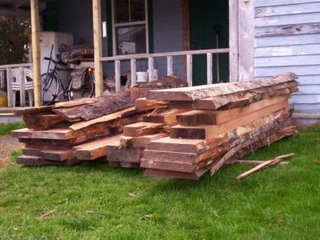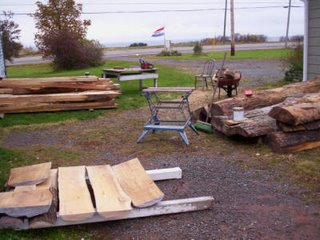Earlier this year I purchased six big logs, a mixture of maples, yellow birch and beech. I hired someone with a tip truck to haul them to the spot in a neighbours woodlot where they were going to be sawn. I'd rather not say too much about getting the truck stuck in the mud and the resulting fun we had getting the logs off. Then we needed a tractor to lift the logs on to the brow, a raised platform that the logs are rolled along and onto the saw mill.
The big day came last Thursday when the bandsaw mill arrived. The whole operation went quite smoothly, and in a few hours I had a trailer loaded up with boards and larger sections from which I can easily cut bowl blanks.

First thing on Friday morning the wood was delivered to my yard. It was quite a good work-out unloading them, as they are still quite sizeable chunks of wood. These are the boards, some nearly two feet wide.

I don't have space indoors to store boards this long, so I have to cut most in half and trim off the ends to remove any cracks. Then the ends are sealed to prevent further splitting.
 Finally I have this pile of wood which is destined to make salad bowls, some of which will be much larger than anything I have made to date. From this photograph it is difficult to appreciate the size of these pieces of wood, but it is a real challenge for me to move them on my own.
Finally I have this pile of wood which is destined to make salad bowls, some of which will be much larger than anything I have made to date. From this photograph it is difficult to appreciate the size of these pieces of wood, but it is a real challenge for me to move them on my own.
I will post more pictures as work continues to show the many steps that go into making a big bowl.
technorati tags: salad bowl, wood-mizer, woodturning



